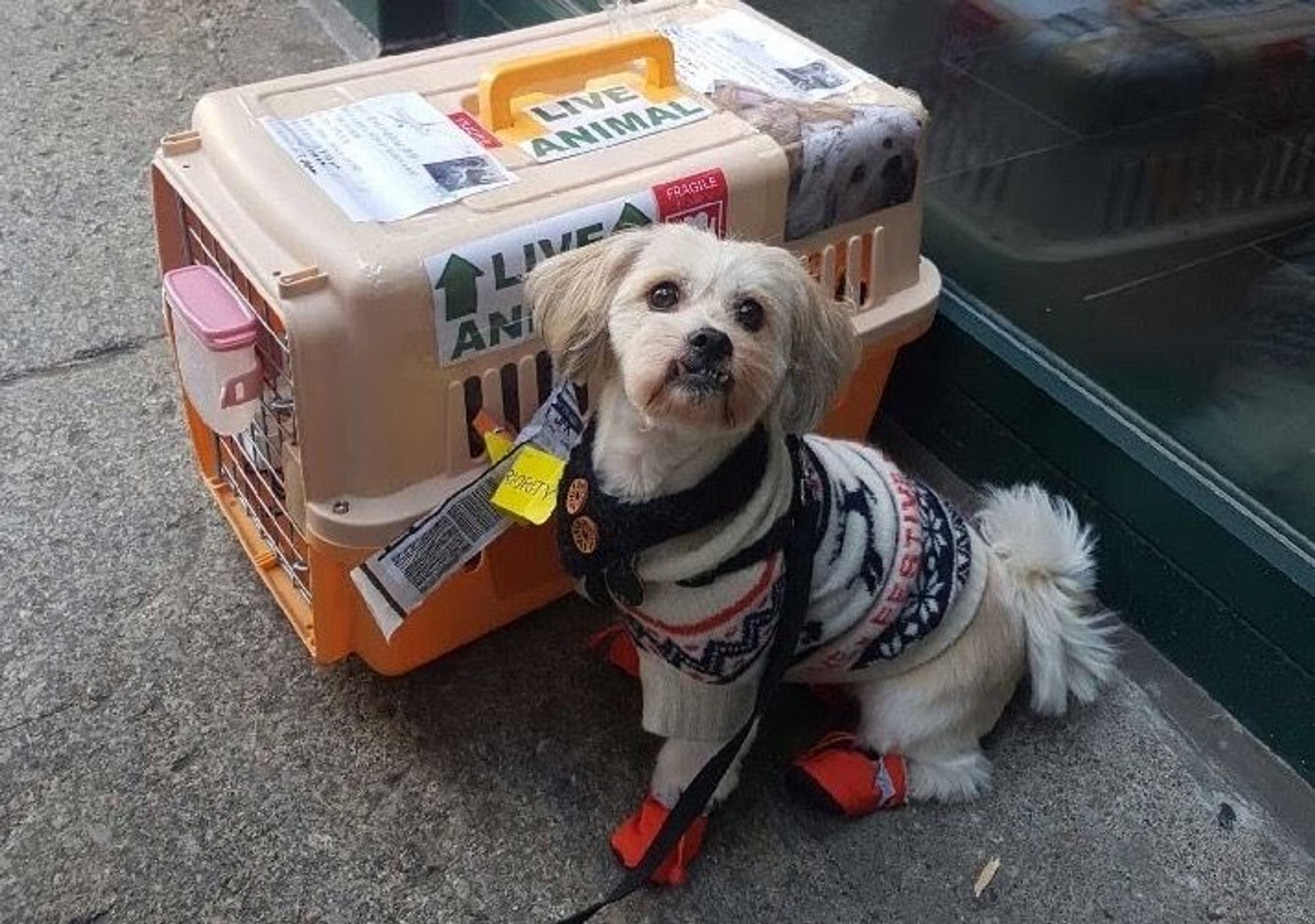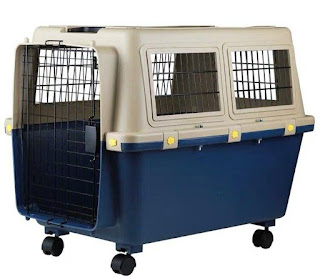Taking a Pet to the U.S.A.: Firsthand Experience

A version of this article was originally posted on 10 MAY 2020 on Stand with Freedom Blogger
Living in China has its benefits, but also its complications. If at some point, you don’t see yourself wanting to stay much longer in the country, most people need to start a lengthy preparation process.
Something that often becomes a hardship is transporting pets. As a result, some people abandon their pets in their haste to leave, which is painful for both human and animal alike.
Luckily, we went through the process already and lay out all the steps to make this fast, efficient, and gives you an idea of how much time you need to start preparing the move out.
Some things you should know before reading this article:
- In China,"pets" are considered dogs and cats, with some exceptions made for large exotic pets. If you have a pet that is a rodent, like a rabbit or ferret, Chinese regulations will NOT allow you to take this animal with you. As a result, you should think very carefully about adopting this kind of animal if you ever plan on leaving China. (Rabbits are the most abandoned animal in China among foreigners as a result of this.)
- This article involves moving a small (under 20 lbs.), not spayed, female dog from Mainland China to the U.S. (a high rabies country to moderate rabies country) on a Chinese airline. We have also include the information needed for cats in this article. If you are moving your pet to a RABIES FREE country (like Japan or Australia), the process is different and longer for the individuals involved. Usually, a quarantine period of 6 months is required for these animals upon entrance to these countries, and other specific requirements are needed.
- If your pet is registered as an Emotional Support Animal (ESA), you still must obtain these documents to have your pet leave China, even if the animal is originally from another country. These documents are required for import and export requirements, and are not just a matter of airline access. ESAs are still permitted to remain in the cabin with their owners with proper documentation on Chinese airlines at the time of this article being written.
- We have put these steps in the order we recommend doing them to utilize your time best. Cost, amount of time needed, and notes are included for each step, but please keep in mind these may have varied since the process took place.
Steps
1. Vaccines and Vaccination Immunity Document
Passport Picture
This is a 2”x 2” picture of your pet (face and body) with a white background.
COST: 15 RMB

TIME TO PREPARE: No more than 12 months, no less than 30 days
TIME TO DO: Printed within a few hours
Note: We took our dog's photo at home and photoshopped the background white, and then had several printed.
Vaccines
- Rabies* REQUIRED BY ALL (1 year) Note: If your pet is being vaccinated for the first time, you must wait at least 6 months before they can leave the country
- Canine Distemper (DOG)
- Parvovirus (DOG)
- Coronavirus (DOG)
- Feline Distemper (CAT)
- Peritonitis (CAT)
- Leucopenia (CAT)
- Kennel Cough-Nasal injection
- Microchip - Recommended - COST: 150 RMB (we did this ourselves)
Vaccine Records
COST:600 RMB

TIME TO PREPARE: A little over a month ahead of time
TIME TO DO: An hour in total for the appointment (local)
Note: Prices vary, for our dog's vaccines this weighed more towards an expensive rate at the time
2. Health Certificate from Certified Vet (Signed and Stamped)
COST:75 RMB

TIME TO PREPARE: No more than 30 days, no less than 10 days
TIME TO DO: Not considering commute time, body check took about 20 minutes total
Note: We went to a government approved veterinary hospital in our province's capital. After performing a full body check, they gave us a form that explains the quality of health of the pet, signed and stamped by the vet.
3. Health Examination and Certificate at Entry-Exit Inspection & Quarantine Bureau
Acquire Transit Permit
COST: 0 RMB

TIME TO PREPARE: ALL previous steps must be completed first
TIME TO DO: Few hours total, finished before lunch
Note: We went to the our town's Entry-Exit Inspection & Quarantine Bureau, and the whole process was relatively smooth. We had to walk around to several offices, but essentially we submitted the Health Certificate and Vaccination Immunity Document and a picture of our dog. She was given a quick examination in the Quarantine area, which she passed. Then we returned to get the Transit Permit.
However, there were some problems with processing the cargo type ["Dog"], so the Bureau recommended using an Import/Export Company that was right next-door, where they processed the Transit Permit for us.
Using Import/Export Company for Transit Permit
COST: 200 RMB
TIME TO PREPARE: Proof of passing quarantine requirements (previous step)
TIME TO DO: Under 30 minutes
Note: It was inputted into the China Customs system, and we just went back to the Bureau to get the official Animal Health Certificate, which is presented to the airport and U.S. Customs to allow our dog to leave China and enter the U.S.
4. Prepare Crate
Crate requirements: Pet needs to be able to stand up and turn around in the crate, must have ventilation on all four sides, should also have an area on the bottom inside that removes where liquid can pass under so your pet is not sitting in urine.
Recommended: Use pet hardware to assemble the crate (not pictured below), not any plastic or easily breakable nuts and bolts.
 |
| (61cm*40cm*39cm,net weight 3.0kg,suitable for pets under 10kg) |
COST: About 120 RMB
TIME TO PREPARE: As soon as you need to prepare your pet for getting used to the crate, we recommend at least a month of training. Shopping took about 4 days for all of the items purchased.
TIME TO DO: About 1 hour to set up the crate
Items for outside the crate:
LABELS:
- Time your pet was last "walked" (poop and pee)
- Time your pet was last fed and watered
- Your pet's name
- Your name and phone number (we included a luggage tag). COST: 9.80 RMB
- Any special conditions pet has (anxiety, aggression, hyperactivity, etc.)
- Any medications you have given your pet (we recommend not giving any to your pet before a flight unless absolutely necessary)
- Picture of you and your pet together
- Photocopy of Animal Health Certificate attached to side of crate
- FRAGILE [red] stickers on each side and top of the crate COST: 1.00 RMB ea.
- LIVE ANIMAL [green] stickers with arrows point UP on each side and top of crate (no arrows on top)
ALL OF THESE LABELS WERE PRINTED ON STANDARD A4 PAPER AND TAPED TO THE SIDES EXCEPT FOR FRAGILE STICKERS I ORDERED.
- Small bag of pet's food (attach to front of crate door) COST: 0 RMB (already had)
Items for inside the crate:
- Water dispenser and food dish (attached to front of crate door) you need to access without having to open the crate - for dogs also add ice to water dispenser COST: About 35 RMB
- Pee pad (goes under removable bottom area) COST: 55 RMB pack of 50
- A soft blanket or something that makes your pet more comfortable COST: 0 RMB
(came with crate, normally 20-50 RMB) - An article of clothing that smells like you (helps with comforting them) Note: I also put a sweater on my dog ahead of time to make sure she wouldn’t get cold on the plane, but this is dependent on your pet. Do not put anything constricting on your pet, and do not place anything in the crate that could cause them to choke like chew treats or toys
Other considerations:
- Leash and/or collar taped strongly to the side of the crate (do not block the air holes) COST: 0 RMB (already had)
- Optional: include a muzzle with the leash and/or collar if you have one COST: About 20 RMB
- Optional: Luggage strap to go around the whole crate COST: 9.9 RMB
- Zip ties to seal your pet's crate door shut at the airport COST: 10 RMB for 100
5. Call the Airline
COST: 0 RMB

TIME TO PREPARE: As soon as you book your flight and know your pet will be traveling with you
TIME TO DO: Phone call took about 20 minutes, waited one business day for confirmation
Notes:
- We used China Southern Airlines, so when you call you are required to tell them the size of your crate (must be under 90x60x66cm max.), the breed and type of pet (no snub-nose breeds allowed), the weight of the crate and pet together (under 32 kg max.), your flight information, and your personal information. You will receive a confirmation via text if your pet is allowed to board the flight with you. Every airline is different, but we had a good experience with CSA, so we recommend using them.
- For China Southern Airlines, you must also purchase an additional baggage voucher for a pet. Purchasing this ahead of time online is cheaper than waiting until you get to the airport, but both are an option. You cannot use your pet as one of your allotted bags.

6. Check State Requirements (U.S. only)
COST: 0 RMB
TIME TO PREPARE: As soon as you book your flight and know your pet will be traveling with you
TIME TO DO: A few minutes of searching on the internet
Note: For example, we flew into a state that required to have a Heartworm-negative pet. We had proof that we supplied our dog with Heartguard medication each month, although this was never checked. This is also supplied on the medical check form.
7. Go to the Airport
COST: No additional cost than Plane ticket, Baggage Voucher cost, and fare if you take a taxi
TIME TO PREPARE: At least 4 hours before your flight
TIME TO DO: About 20-30 minutes to check-in bags and pet
Notes:
- Bring a pen or marker to write the times needed on the outside of your pet's crate (see above)
- Make sure you have ALL your required documents and photocopies of each with you at all times. (Folders are helpful)
- Have your pet go to the bathroom right before placing them in the crate for the last time if you can.
- Have your pet eat right before placing them in the crate for the last time if you can. (They might be too nervous for several hours after they are in the airport/plane to eat)
- Get your boarding pass with your pet - the airline will have you fill out a waiver form here for your pet and weigh it.
- Pack your pet up with netting and rope supplied by the airport, the airline will advise you.
- Bring your pet to Oversized Luggage after you have received your boarding pass and make sure you get a Baggage Tag/Receipt (they will attach one to your pet’s crate as well).
- As you are boarding the plane, ask one of the flight attendants if they can remind the captain to keep the temperature of the cargo the same as the cabin because your pet is there (this is standard when pets are checked in, but it never hurts to be sure).
- When you land - have U.S. Customs check your Animal Health Certificate, then pick up your pet at the Oversized Luggage area when you pick up the rest of your luggage.
**Make sure that your flight is DIRECT, otherwise you will need to also follow any requirements for importing pets at any stopover you have for your flight, unless all flights are through the same airline.**